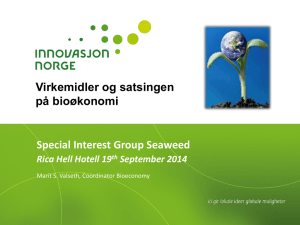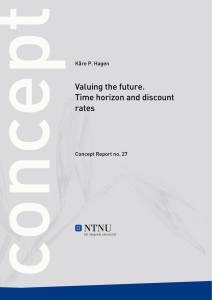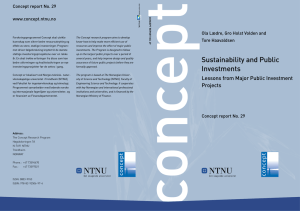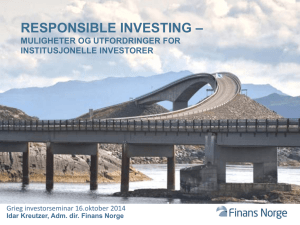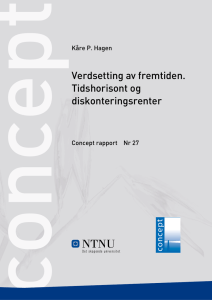The Fjord, the City and the Opera. An Evaluation - Concept
advertisement
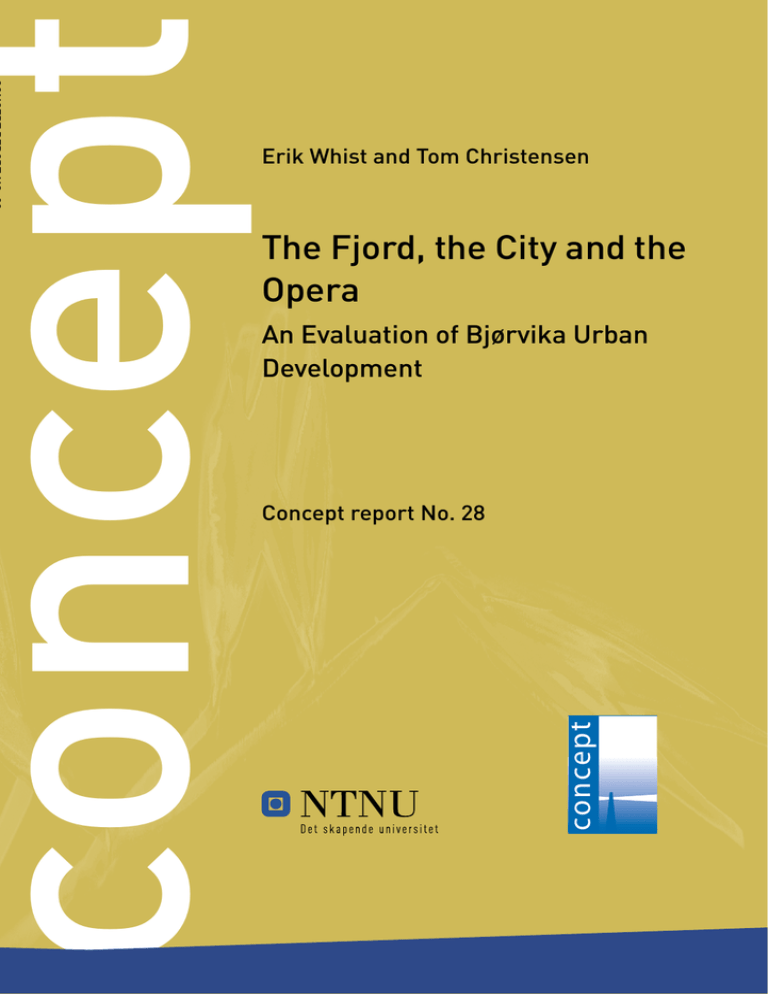
The Fjord, the City and the Opera An Evaluation of Bjørvika Urban Development Concept report No. 28 concept concept Erik Whist and Tom Christensen concept Erik Whist and Tom Christensen The Fjord, the City and the Opera An Evaluation of Bjørvika Urban Development Concept report No. 28 © Concept Research Programme 2012 Concept report no. 28 The Fjord, the City and the Opera. An Evaluation of Bjørvika Urban Development English summary Erik Whist and Tom Christensen ISSN: 0803-9763 (paper version) ISSN: 0804-5585 (web version) ISBN: 978-82-92506-95-0 (paper version) ISBN: 978-82-92506-96-7 (web version) Date: Publisher: 21.03.2012 Concept Reserach Programme Norwegian University of Science and Technology 7491 NTNU – Trondheim Norway www.concept.ntnu.no Summary This report gives an analysis of the two projects E18 Bjørvika and New Opera House, which both are parts of what is referred to as Bjørvika Development. There are four decisions which constitute the basis for development of Bjørvika. The first was Parliament’s decision in June 1999 to build the new opera house in Bjørvika. The second was Parliament’s decision in 2002 to allocate money to the E18 Bjørvika project, which included the immersed tunnel. Third was the City Parliament’s resolution in 2001, which consisted of 36 points with objectives and guidelines for the planning and development of Bjørvika. Fourth, was the City Parliament’s adoption in 2003 of the zoning plan for Bjørvika. Today it looks as if Bjørvika Development, which will only be fully finished towards 2020, will be a successful project. The implementation has so far been according to plans. Review of the various objectives shows that they are likely to be attained. The point of departure for the project was that this should bring back the relation between the city and the fjord. This required a change in the road system, which from a city planning point of view would best be solved with an immersed tunnel. Through various studies and plans, including impact assessments and architect competitions, shared understanding of possibilities and planning principles was established between stakeholders with different interests, who jointly prepared the zoning plan, approved by the City Parliament in 2003. The State came to play a very active role. Parliament was a champion together with local interests. It was Parliament who, in 1993, allocated 30 million NOK which made it possible to undertake studies and start planning, which comprised both transportation and urban development. Thereafter Parliament actively intervened to get in place a scheme for financing the project with contributions from the different stakeholders. Parliament told the Government to get involved in order to solve obstacles to the development of the area. This is a project where central government investments trigger large benefits and profits for nongovernment actors. This applies to Oslo City, which got access to land for urban development, and property owners, and whose land acquired dramatic increase in value. Parliament therefore made it a condition for Government financing that Oslo City, users of roads and landowners would have to contribute to the financing of the project. It is clear that without the contribution from Oslo City, Parliament would not have approved and allocated money to the E18 project. In the early stage a comprehensive set of binding agreements for the implementation of Bjørvika Development was put in place by the involved private and public institutions. This set of agreements is considered decisive for the successful implementation of Bjørvika Development. It is still equally valid and binding and no changes have been introduced since it was signed in 2003. New Opera House appears to be a successful project. The construction of the building went well and a review of the objectives for the new opera house shows that objectives are being attained: • Number of visitors has doubled from 136.000 in 2007 to 276.000 in 2010. • New groups of spectators have come to the opera. A survey in 2010 showed an increase of lower income groups and people living in areas of the city where the inhabitants are traditionally not associated with opera. • Number of performances has doubled since 2006. • The number of children and youth spectators has increased. Concept report no. 28 • There is still room for improvement of the artistic quality because the staff has not yet been able to fully use the complicated technical equipment. • The opera house is a monumental building and has become one of the most important tourist attractions in the city. Some 5 million persons have visited the building since it was opened in 2008. Both New Opera House and E 18 Bjørvika contribute to urban development of Bjørvika. The decision making processes in the early phase of these projects is quite special because many stakeholders considered these projects to be the start up for urban development of the area. In the early phase of the New Opera House project the focus was on the cultural dimension of the project, but a solution and decision was not made before the links to the urban development of Bjørvika were established. The cultural aspects are of course important once the opera is functioning in the new building. However, urban development now proceeds without much of a connection to these cultural aspects of the New Opera House. During the early phase the E18 Bjørvika project is disconnected from the opera-process, but eventually these are connected again. As a transportation and road project there is continuity between the early phase and the later implementation and operation phases, but the focus is all the time to open up new areas for urban development. The decision making process for the New opera house, E18 Bjørvika and Bjørvika Development is characterized by complex coalitions, always with a focus on urban development of the area. Coalitions, which are initiated or supported by Government, are created by public and private actors that make it possible to develop urban space around the opera for apartments and businesses. This brings about the expected benefits for these actors and also for the public. At the same time questions may be posed about the objectives and public benefit of such large scale development, the profits for the private sector, the investment in the costly immersed tunnel and other questions on alternative use of the funds elsewhere in Oslo and in other parts of the country, and which may first be answered when all building investments have been fulfilled around 2020. Concept report no. 28 Concept rapportserie Papirtrykk: ISSN 0803-9763 Elektronisk utgave på internett: ISSN 0804-5585 Lastes ned fra: www.concept.ntnu.no/publikasjoner/rapportserie Rapport Tittel Forfatter Nr. 1 Styring av prosjektporteføljer i staten. Usikkerhetsavsetning på porteføljenivå Stein Berntsen og Thorleif Sunde Project Portfolio Management. Estimating Provisions for Uncertainty at Portfolio Level. Nr. 2 Statlig styring av prosjektledelse. Empiri og økonomiske prinsipper. Dag Morten Dalen, Ola Lædre og Christian Riis Economic Incentives in Public Project Management Nr. 3 Beslutningsunderlag og beslutninger i store statlige investeringsprosjekt Stein V. Larsen, Eilif Holte og Sverre Haanæs Decisions and the Basis for Decisions in Major Public Investment Projects Nr. 4 Konseptutvikling og evaluering i store statlige investeringsprosjekt Concept Development and Evaluation in Major Public Investment Projects Nr. 5 Bedre behovsanalyser. Erfaringer og anbefalinger om behovsanalyser i store offentlige investeringsprosjekt Hege Gry Solheim, Erik Dammen, Håvard O. Skaldebø, Eystein Myking, Elisabeth K. Svendsen og Paul Torgersen Petter Næss Needs Analysis in Major Public Investment Projects. Lessons and Recommendations Nr. 6 Målformulering i store statlige investeringsprosjekt Ole Jonny Klakegg Alignment of Objectives in Major Public Investment Projects Nr. 7 Hvordan trur vi at det blir? Effektvurderinger av store offentlige prosjekt Nils Olsson Up-front Conjecture of Anticipated Effects of Major Public Investment Projects Nr. 8 Realopsjoner og fleksibilitet i store offentlige investeringsprosjekt Kjell Arne Brekke Real Options and Flexibility in Major Public Investment Projects Nr. 9 Bedre utforming av store offentlige investeringsprosjekter. Vurdering av behov, mål og effekt i tidligfasen Petter Næss med bidrag fra Kjell Arne Brekke, Nils Olsson og Ole Jonny Klakegg Improved Design of Public Investment Projects. Up-front Appraisal of Needs, Objectives and Effects Nr. 10 Nr. 11 Usikkerhetsanalyse – Kontekst og grunnlag Uncertainty Analysis – Context and Foundations Kjell Austeng, Olav Torp, Jon Terje Midtbø, Ingemund Jordanger, og Ole Morten Magnussen Usikkerhetsanalyse – Modellering, estimering og beregning Frode Drevland, Kjell Austeng og Olav Torp Uncertainty Analysis – Modeling, Estimation and Calculation Nr. 12 Metoder for usikkerhetsanalyse Uncertainty Analysis – Methodology Nr. 13 Usikkerhetsanalyse – Feilkilder i metode og beregning Uncertainty Analysis – Methodological Errors in Data and Analysis Nr. 14 Positiv usikkerhet og økt verdiskaping Kjell Austeng, Jon Terje Midtbø, Vidar Helland, Olav Torp og Ingemund Jordanger Kjell Austeng, Vibeke Binz og Frode Drevland Ingemund Jordanger Positive Uncertainty and Increasing Return on Investments Nr. 15 Kostnadsusikkerhet i store statlige investeringsprosjekter; Empiriske studier basert på KS2 Cost Uncertainty in Large Public Investment Projects. Empirical Studies Concept report no. 28 Olav Torp (red.), Ole Morten Magnussen, Nils Olsson og Ole Jonny Klakegg Rapport Tittel Forfatter Nr. 16 Kontrahering i prosjektets tidligfase. Forsvarets anskaffelser. Erik N. Warberg Procurement in a Project’s Early Phases. Defense Aquisitions Nr. 17 Beslutninger på svakt informasjonsgrunnlag. Tilnærminger og utfordringer i prosjekters tidlige fase Kjell Sunnevåg (red.) Decisions Based on Scant Information. Challenges and Tools During the Front-end Phases of Projects Nr. 18 Flermålsanalyser i store statlige investeringsprosjekt Multi-Criteria Decision Analysis In Major Public Investment Projects Nr. 19 Effektvurdering av store statlige investeringsprosjekter Impact Assessment of Major Public Investment Projects Nr. 20 Investorers vurdering av prosjekters godhet Investors’ Appraisal of Project Feasibility Nr. 21 Logisk minimalisme, rasjonalitet - og de avgjørende valg Major Projects: Logical Minimalism, Rationality and Grand Choices Nr. 22 Miljøøkonomi og samfunnsøkonomisk lønnsomhet Ingemund Jordanger, Stein Malerud, Harald Minken, Arvid Strand Bjørn Andersen, Svein Bråthen, Tom Fagerhaug, Ola Nafstad, Petter Næss og Nils Olsson Nils Olsson, Stein Frydenberg, Erik W. Jakobsen, Svein Arne Jessen, Roger Sørheim og Lillian Waagø Knut Samset, Arvid Strand og Vincent F. Hendricks Kåre P. Hagen Environmental Economics and Economic Viability Nr. 23 Nr. 24 The Norwegian Front-End Governance Regime of Major Public Projects – A Theoretically Based Analysis and Evaluation Tom Christensen Markedsorienterte styringsmetoder i miljøpolitikken Kåre P. Hagen Market oriented approaches to environmental policy Nr. 25 Regime for planlegging og beslutning i sykehusprosjekter Planning and Decision Making in Hospital Projects. Lessons with the Norwegian Governance Scheme. Nr. 26 Politisk styring, lokal rasjonalitet og komplekse koalisjoner. Tidligfaseprosessen i store offentlige investeringsprosjekter Asmund Myrbostad, Tarald Rohde, Pål Martinussen og Marte Lauvsnes Erik Whist, Tom Christensen Political Control, Local Rationality and Complex Coalitions. Focus on the front-end of large public investment projects Nr. 27 Verdsetting av fremtiden. Tidshorisont og diskonteringsrenter Kåre P. Hagen Valuing the future. Time horizon and discount rates Nr. 28 Fjorden, byen og operaen. En evaluering av Bjørvikautbyggingen i et beslutningsteoretisk perspektiv The Fjord, the City and the Opera. An Evaluation of Bjørvika Urban Development Concept report no. 28 Erik Whist, Tom Christensen Nasjonalt sertifikat: 1660 Concept report No. 28 Tapir Uttrykk www.concept.ntnu.no Forskningsprogrammet Concept skal utvikle The Concept research program aims to develop kunnskap som sikrer bedre ressursutnytting og know-how to help make more efficient use of effekt av store, statlige investeringer. Program- resources and improve the effect of major public met driver følgeforskning knyttet til de største investments. The Program is designed to follow statlige investeringsprosjektene over en rekke up on the largest public projects over a period of år. En skal trekke erfaringer fra disse som kan several years, and help improve design and quality bedre utformingen og kvalitetssikringen av nye assurance of future public projects before they are investeringsprosjekter før de settes i gang. formally approved. Concept er lokalisert ved Norges teknisk- natur- The program is based at The Norwegian Univer- vitenskapelige universitet i Trondheim (NTNU), sity of Science and Technology (NTNU), Faculty of ved Fakultet for ingeniørvitenskap og teknologi. Engineering Science and Technology. It cooperates Programmet samarbeider med ledende norske with key Norwegian and international professional og internasjonale fagmiljøer og universiteter, og institutions and universities, and is financed by the er finansiert av Finansdepartementet. Norwegian Ministry of Finance. Address: The Concept Research Program Høgskoleringen 7A Trondheim NORWAY Phone.: +47 73594670 Fax.: +47 73597021 ISSN: 0803-9763 ISBN: 978-82-92506-95-0 concept N-7491 NTNU
